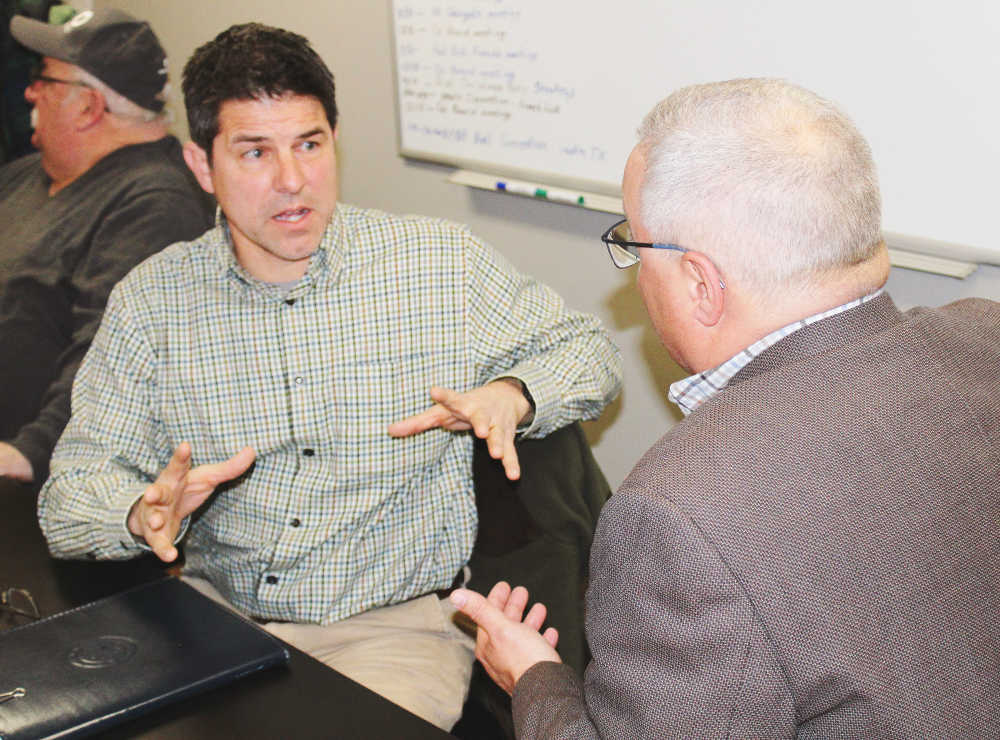Broadband and bullets get Legislative Update attention

With six weeks to go in the 2019 session of the Indiana General Assembly, much of the attention at Indianapolis has been directed toward the big-ticket bills.
Big issues like opioid problems, teachers’ salaries, school funding, gaming and sports wagering and, of course, hate crimes, have dominated discussion not only at the Statehouse but at the first two Putnam County Farm Bureau-sponsored Legislative Update sessions.
However, that was not the case Saturday for the session’s third and final Legislative Update program at the Farm Bureau Insurance office in Greencastle.
State broadband development got perhaps the most attention from State Senate President Pro Tem Rodric Bray (R-Martinsville) and District 44 State Rep. Beau Baird (R-Greencastle) and the 25 constituents who came out for an 8 a.m. program on Saturday morning.
It was Steve Cash, who moderates the Legislative Update sessions, who raised the issue while monitoring bills Farm Bureau has been keeping its eye on.
“Broadband work has been pretty disappointing,” Farm Bureau President Cash said, noting that to date only one bill concerning the subject, Senate Bill 460, has made it through the legislature.
And that’s not even a bill that might expand upon the $110 million Indiana Gov. Eric Holcomb has targeted for rural broadband.
That’s the bill that allows broadband infrastructure to run along highways like other utility in the state, Bray said, noting it’s particularly important in southern Indiana, where there is virtually no broadband available.
Senate Bill 460 on broadband development provides that the department of transportation may not charge an access rate or any other charge or fee, on an annual basis or otherwise, for certain communications infrastructure that is located before March 14, 2019, in any rights-of-way owned or controlled by the department. It also provides that, before July 1, 2020, the department shall adopt rules regarding utility facility relocation for purposes of construction contracts, and that the department may create a broadband corridor program.
Rep. Beau Baird, who has made broadband an area of importance during this, his freshman year in the legislature, said one idea is to focus on broadband availability as a regional issue and not a local problem.
“If we can all come together as a region, it makes it easier to invest dollars here,” Baird said, pointing to Holcomb’s $110 million plan that is an initiative in need of funding.
“It’s easy just to say ‘do it,’” he said, noting that it would take $40 million alone just to bring capable broadband to Parke County.
Multiplying that across the state, Baird said, would be expensive and necessitate the cooperation of all facets of Hoosier business and government.
“The state can’t do it alone,” he said. “Companies can’t do it alone.”
Meanwhile, Sen. Bray shared information about what he called “the gold standard” for how to address the possibility of arming teachers with guns in schools in an effort to combat the school shooting issue.
A veteran educator raised the issue Saturday morning, noting that she would never take part in such a program.
Sen. Bray pointed to Jay County as the “gold standard” for how it might work.
“Keep in mind that nobody has the crystal ball to know where the next one (school shooting) is coming from,” Bray reasoned, noting that mental health issues are vital to counteracting the problem but that ”mental health isn’t the silver bullet either.”
Schools need to take other precautions, he suggested, such as making doors to buildings and classrooms “more robust” and windows tougher to see into, reasoning those are things that can slow a potential shooter’s progress as he or she is trying to get to students.
No teacher would be asked to carry a gun, Bray said, noting that would only happen if a teacher agreed to be armed and after he or she had gone through a mental assessment, weapons training and pass a proficiency test at 90 percent.
And even then, the weapon would be kept inside a biometric safe that could only be opened by the teacher’s thumbprint, he said.
“A lot of schools would say, ’I don’t want to do that,’ which I understand,” Bray said. “But it’s the only way I’d approve of that.”
